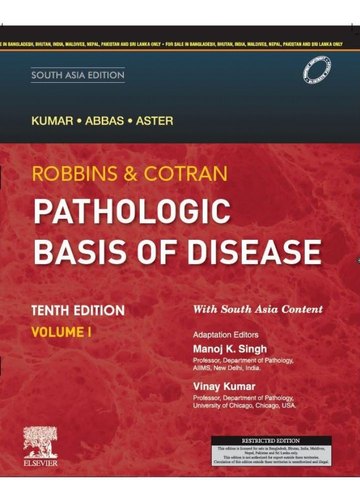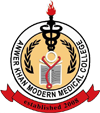Anwer Khan Modern Medical College
Library Management System

| Title: | Robbins and Cotran pathologic basis of disease: vol. 1. |
| Author Name: | Vinay Kumar. |
| Author Sur Name: | KUMAR, Vinay. |
| Other's Author Name: | Abul K. Abbas and Jon C. Aster. |
| Author information: |
|
| Edition/Published: | 10th ed. _New Delhi : Elsevier , 2021 |
| New to this edition: |
|
|
Physical Description: xii, 1379p, : <p>xii, illustrations (chiefly color) ; </p>.; 29 cm |
| Notes | Includes bibliographical references and indexes. |
| Bibliography: | Includes bibliographical references. |
| Includes Index: | Includes index |
| ISBN No's: | 978-81-312-6211-5 |
| Bar Code's: | |
| Shelf Location's: |
| Classification | |
| Subject: | Pathology |
| Dewey Class No: | 616.07 |
| LC Classification: | RB111 .R62 2020 |
| Other's Book Information | |
| Book ID No: | 2605 |
| Total Books: | 1 |
| Date of collection's: | 30-Dec-2021 |
| Donation / Purchase: | Purchase |
| Language: | English |
| Status: | Available |
| Department: | Pathology |
| Synopsis: |
|
| Description: |
|
| Key Features: |
|
| Summary: |
The 10th edition of Robbins and Cotran Pathology, with excellent readings and illustrations, offers detailed and up-to-date descriptions of human disease as well as the cellular and molecular environment. This bestseller delivers the latest and most important pathology discoveries in an easy-to-read format, sharing and giving you the best insight into today’s fundamental science and clinical content. Over 1,000 high-quality color photos and illustrations provide fresh information on molecular biology, disease classification, new drugs, chemotherapy and more. This great training package also includes a complete e-book with additional content available on the website. Educational consultation Offers unique, reliable, and easy-to-read coverage, ideal for preparing USMLE or spreadsheets and seminars. New treatment for hepatitis C includes important things to know such as lymphoma, advanced protein response, non-cell death pathways, coronavirus infection, and more, liquid biopsy to diagnose cancer. And regulate iron absorption, blood and blood vessels, thrombosis, thrombocytopenia, inflammation of meiosis, hereditary apparatus for the treatment of cystitis and others.
Use colorful and intuitive layouts to simplify the learning process and quickly introduce the information you need, with teaching features such as general descriptions, basic concepts, measurements, and bold charts introduced at the beginning of. Each chapter shows complex concepts and new and microscopic numbers for a clearer position. Provides the latest information on molecular and genetic testing, disease methods, individual drugs and therapeutic effects of human disease, the role of pathogens and metabolism in non-communicable diseases, and more. Provides access to a wide range of interactive online dietary supplements such as pathology research, videos, self-assessment questions, and targeted treatment plans for chemotherapy, interactions, and more. An extended e-book is included with your modern e-book purchase. You can access all text, images and book links on different devices. |
| Abstract: |
This best-selling text delivers the latest, most essential pathology knowledge in a readable, interesting manner, ensuring optimal understanding of the latest basic science and clinical content. More than 1,000 high-quality photographs and full-color illustrations highlight new information in molecular biology, disease classifications, new drugs and drug therapies, and much more. This superb learning package also includes an enhanced eBook with a full complement of ancillary content on Student Consult. |
| Preface: |
The tenth edition of Pathologic Basis of Disease we look to the future of pathology as a discipline and how this textbook can remain most useful to readers in the twenty-first century. It is obvious that an understanding “The pathologist is interested not only in the recognition of structural alterations, but also in their significance, i.e., the effects of these changes on cellular and tissue function and ultimately the effect of these changes on the patient. It is not a discipline isolated from the living patient, but rather a basic approach to a better understanding of disease and therefore a foundation of sound clinical medicine.” • In Chapter 3, we have married morphology with molecular mechanisms. Thus, different patterns of inflammation can be related to distinct molecular pathways.
We have repeatedly been told by readers that up-to-datedness is a special feature that makes this book very valuable. We have strived to remain current by providing new information from the recent literature, up to the current year, and by adding coverage of the COVID-19 epidemic. All three of us have reviewed, critiqued, and edited each chapter to ensure the uniformity of style and flow that have been the hallmarks of the book. Together, we hope that we have succeeded in equipping the readers with the scientific basis for the practice of medicine and in whetting their appetite for learning beyond what can be offered in any textbook. |
| Content: |
CHAPTER 1 The Cell as a Unit of Health and Disease 1 CHAPTER 18 Liver and Gallbladder 823 South Asia Content 1329 |
